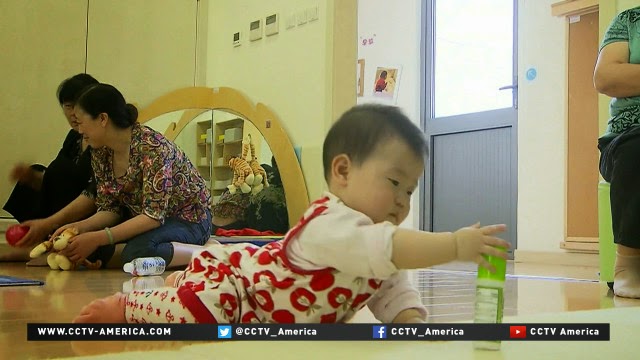“A lot of women working in high-competitive jobs look like they are less likely to have a second child,” Professor Zheng ZhenZhen of the Chinese Academy of Social Science’s Institute of population and labor statistics said.
Some experts are calling for an accelerated removal of restrictions on a second child, warning that the country’s birthrate is moving towards a dangerously low level.
A poll taken place in five provinces in China, including Guangdong, Shanghai and Beijing showed it doesn’t matter if families already had a child, over 30 percent said they wouldn’t have a second child.
A report from the Chinese Academy of Social Sciences, also known as CASS, said the fertility rate in China is at a dangerously low level, at 1.4 children per woman.
This number is close to the global warning of a low fertility trap, which could result in an ageing population and a labor shortage. Experts are calling on the government to fully lift all restrictions to have a second child, and the sooner the better, along with adjusting the family planning policy even more.
Stanford analysis of working age (15-64) population in 2050 based on 2008 UN medium projection. This is before the recent China policy shift which is boosting births by 1 million per year from about 15.5 million per year.
China’s child policies now will determine if China has 1.3 billion in 2050 or 1.65 billion
China is expecting at least one million more births in 2015 than last year, as a result of policy changes. A total of 16.9 million new citizens came into the world in 2014, 470,000 more than in 2013, said the China Population Association (CPA) two weeks ago.
As of the end of 2014, around one million couples had applied to have a second child.
Zhai Zhenwu, head of the CPA, said many families are at the preparing stage and the number of newborns is expected to increase noticeably in 2015.
As the birth policy may continue to be eased, the baby boom may last for five to eight years, said Zhai, adding that more efforts will be made in the public service sector to meet the challenge.
After the change (plus a complete lifting of any restriction children before 2018 and a shift to incentiving babies before 2022), I estimate
2020: 1.43 billion
2030: 1.53 billion
2040: 1.6 billion
2050: 1.65 billion
Working Age Population (15-64) in 2050
Stanford had a projection of working age population
If population policies in China boost child births from 15 million to 23 million for the next 20 years then the China would have 160 million more working age people in 2050. This would prevent a drop of 110 million and perhaps increase the working age population by 5%. Working age population now is about 970 million.
Other ways to deal with the shrinking working age populations would be to increase retirement ages from 64 to say 74. This would keep the working age population stable in the face of 15% drop in overall population in the 15-64 range.
China also has a lower number of people in the urban areas in more productive jobs today. China is also boosting its more productive college educated workforce.
The overall economic impact would be effected by
* how many working age population
* when do people retired
* how urbanized – China will go from 50% to 70-80% in 2050
* how educated and productive is the workforce
* how much automation and efficiency is there
SOURCES – CCTV-America, Monash University

Brian Wang is a Futurist Thought Leader and a popular Science blogger with 1 million readers per month. His blog Nextbigfuture.com is ranked #1 Science News Blog. It covers many disruptive technology and trends including Space, Robotics, Artificial Intelligence, Medicine, Anti-aging Biotechnology, and Nanotechnology.
Known for identifying cutting edge technologies, he is currently a Co-Founder of a startup and fundraiser for high potential early-stage companies. He is the Head of Research for Allocations for deep technology investments and an Angel Investor at Space Angels.
A frequent speaker at corporations, he has been a TEDx speaker, a Singularity University speaker and guest at numerous interviews for radio and podcasts. He is open to public speaking and advising engagements.





